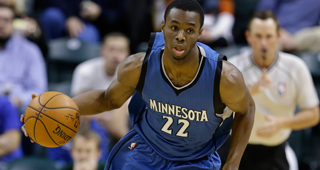The Minnesota Timberwolves' unusual combination of talented players both young and old provides a short-term challenge that they can convert into a meaningful long-term opportunity.
Unlike most teams towards the bottom of the league, Minnesota has significant depth, albeit unbalanced in terms of positions and roles. They also have a fascinating young core with potential stars Karl-Anthony Towns and Andrew Wiggins, as well as interesting talents like Ricky Rubio (still just 25), Zach Lavine (20), Shabazz Muhammad (23) and Tyus Jones (19).
With the playoffs out of the picture, Sam Mitchell and the Wolves owe it to themselves to spend the final three months of this season figuring out exactly what they have in these young players and how everything fits together. Their unique combination of players allows them to try something truly fascinating: a dry run.
As a practical matter, the dry run would focus on making the Wiggins/Towns minutes as reflective of their long-term roles as possible. Giving them two rest periods each half and playing time in the low thirties (or high twenties if they want to be more judicious this season) would get them used to the pattern and would also allow them to try different combinations of surrounding talent. For example, Minnesota could start games with Rubio, LaVine, Wiggins, Garnett and Towns then pull Towns, Wiggins and possibly Garnett with about 6:30 or 7:00 remaining in the first. That would allow them to get a rest before returning late in the period with Bjelica, Muhammad and either Rubio or Tyus Jones (to see how he does with those players). They could then use the quarter break to make a swap or two and do something similar in the remaining quarters to try out different combinations.
At its core, the dry run concept acknowledges that Minnesota’s path to long-term success runs through Towns and Wiggins. As such, their primary focus the rest of the season should be to prepare those talents for their eventual role in situations that resemble their future in terms of opposition and surrounding talent.
Karl-Anthony Towns’ ability to protect the rim and space the floor makes him a fascinating center in a changing league. Unfortunately, Minnesota has Gorgui Dieng and Nikola Pekovic on roster who are both true centers. Sam Mitchell has played Towns next to one of those centers for more than one-fifth of his minutes this season, which should stop immediately because it takes away from Towns’ strengths without adding useful NBA experience. Minnesota has more than enough natural power forwards who can complement Towns in different ways including regular starter Kevin Garnett, 2014-15 Euroleague MVP Nemanja Bjelica and Adreian Payne. Each of those players brings aspects of a potential long-term power forward fit next to Towns and thus allows the team to see what works and does not before they make draft picks and sign free agents over the summer.
While Andrew Wiggins is next in terms of priority, his flexibility both offensively and defensively means that the team should try him with a variety of teammates and roles to see what comes most naturally at this point. Zach LaVine does not have that same kind of pliability, partially because Minnesota continues their attempt to mold him into someone who can run an offense despite a trove of evidence to the contrary. Per NBAwowy, LaVine has played a whopping 677 minutes without a true point guard on the floor, more than two-thirds of his 2015-16 playing time. Despite mostly competing against backups, the Wolves have scored just 101.2 points per 100 possessions in these minutes, in line with what Chicago has done this season (23rd in the NBA). LaVine’s ability to run the floor, finish in transition and exploit defensive breakdowns works far better off the ball and shifting him over full-time puts his shooting decisions in the hands of point guards, which will make LaVine a more efficient and dangerous offensive force.
The other player hurt most by Minnesota’s current rotations is Shabazz Muhammad. A 2013 lottery pick, Muhammad has shown flashes this year but has only played 180 minutes with Towns and Wiggins and 182 with Ricky Rubio, about 19% of his playing time for the season. That little time with Minnesota’s core means the Wolves are not learning enough about how Muhammad fits with their key players considering he will be up for an extension over the summer.
The “dry run” also allows Sam Mitchell to show why he should be Minnesota’s coach beyond this season. Running something closer to a modern NBA offense with the team’s future core would show ownership that he can bridge the gap and lead these players through the next few phases in their development. It also helps Mitchell in terms of getting another job eventually because it would reflect a versatility and willingness to utilize the talent in front of him, which organizations value considering the amount of turnover in the league today.
That sort of structure also allows players like LaVine and Muhammad to get time with the Wiggins/Towns duo while still opening up enough minutes to give them NBA experience in a variety of capacities. Players like Andre Miller, Tayshaun Prince and one of Dieng and Pekovic (likely Pek) would lose out but the team’s future must take precedence.
Embracing the ability of the present to inform and build a better future gives Minnesota a remarkable opportunity to try a dry run that will allow them to better prepare and evaluate the league’s most fascinating young core.



